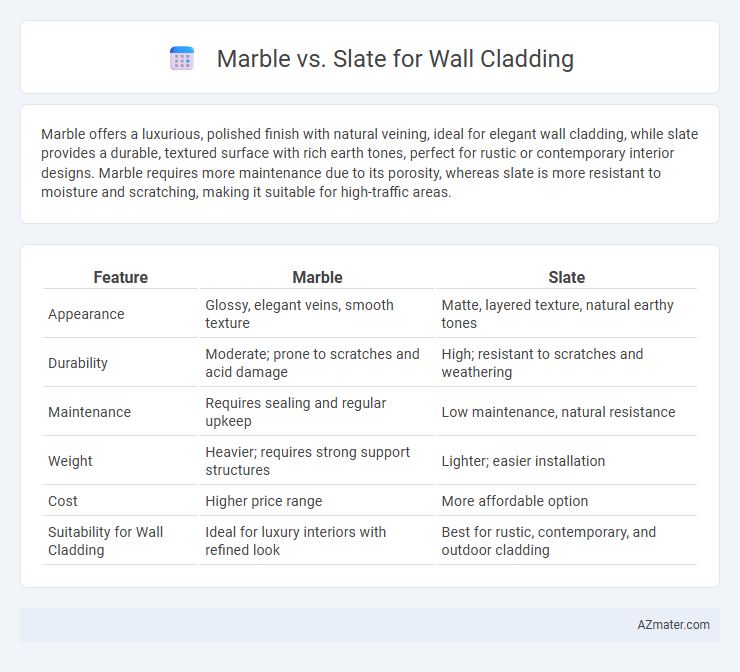Marble offers a luxurious, polished finish with natural veining, ideal for elegant wall cladding, while slate provides a durable, textured surface with rich earth tones, perfect for rustic or contemporary interior designs. Marble requires more maintenance due to its porosity, whereas slate is more resistant to moisture and scratching, making it suitable for high-traffic areas.
Table of Comparison
| Feature | Marble | Slate |
|---|---|---|
| Appearance | Glossy, elegant veins, smooth texture | Matte, layered texture, natural earthy tones |
| Durability | Moderate; prone to scratches and acid damage | High; resistant to scratches and weathering |
| Maintenance | Requires sealing and regular upkeep | Low maintenance, natural resistance |
| Weight | Heavier; requires strong support structures | Lighter; easier installation |
| Cost | Higher price range | More affordable option |
| Suitability for Wall Cladding | Ideal for luxury interiors with refined look | Best for rustic, contemporary, and outdoor cladding |
Introduction: Marble vs Slate for Wall Cladding
Marble and slate are popular choices for wall cladding, each offering unique aesthetic and functional benefits. Marble provides a luxurious, polished finish with natural veining that enhances interior elegance, while slate delivers a textured, rustic appearance with excellent durability and slip resistance. Selection between marble and slate depends on the desired visual impact, maintenance requirements, and environmental exposure of the cladded wall.
Natural Beauty and Aesthetic Appeal
Marble offers a luxurious and elegant appearance with its smooth texture and unique veining patterns, making it a popular choice for sophisticated wall cladding. Slate provides a rustic, textured look with rich, earthy tones that enhance natural charm and depth in interior and exterior designs. Both materials deliver distinct aesthetic appeals, with marble excelling in brightness and refinement, while slate brings warmth and a timeless, rugged beauty.
Durability and Strength Comparison
Marble offers a high level of durability with its natural crystallized composition, making it resistant to moderate wear and tear but susceptible to scratching and acidic damage. Slate, composed of fine-grained metamorphic rock, exhibits superior strength and weather resistance, making it highly suitable for exterior wall cladding in harsh environments. Overall, slate outperforms marble in terms of long-term durability and structural integrity for wall cladding applications.
Maintenance Requirements
Marble requires regular sealing and gentle cleaning with pH-neutral cleaners to maintain its polished surface and prevent staining, making it moderately high maintenance for wall cladding. Slate, known for its durability and natural slip resistance, demands less frequent sealing and simple cleaning with mild soap and water, offering a more low-maintenance option. Both materials benefit from routine inspections to address potential cracks or chips, ensuring long-lasting aesthetic appeal and structural integrity.
Installation Process and Challenges
Marble wall cladding requires precise cutting and polishing techniques to maintain its natural veining and avoid surface damage, often demanding skilled labor for proper installation. Slate, being more brittle and layered, poses challenges in handling and requires careful fastening to prevent splitting during installation. Both materials necessitate specialized tools and expertise, with marble typically needing a more time-consuming and delicate installation process compared to slate.
Cost Analysis: Marble vs Slate
Marble wall cladding typically costs between $50 and $150 per square foot, influenced by grade and origin, while slate ranges from $35 to $90 per square foot, offering a more budget-friendly option. Installation expenses for marble tend to be higher due to its weight and fragility, often requiring specialized labor, whereas slate's lighter, more durable nature can reduce installation time and costs. Long-term maintenance costs favor slate as it resists staining and requires less frequent sealing compared to marble, which is more porous and prone to etching.
Applications and Versatility
Marble offers a luxurious, polished finish ideal for high-end interior wall cladding in spaces like living rooms, hotels, and commercial lobbies where aesthetic appeal is paramount. Slate provides a textured, natural look with excellent durability, making it suitable for both interior and exterior wall applications, including feature walls, facades, and garden walls. The versatility of slate in withstanding harsh weather conditions and its slip-resistant properties give it an edge in outdoor and wet area installations compared to marble.
Environmental Impact and Sustainability
Marble extraction involves significant quarrying impacts, consuming high energy and generating considerable waste, while slate quarrying generally requires less energy and produces fewer emissions, making it more environmentally friendly. Slate's natural durability and low porosity contribute to longer lifespan and reduced maintenance, enhancing sustainability compared to marble's susceptibility to acid rain and staining. Recyclability and the potential for local sourcing further position slate as a greener choice for sustainable wall cladding.
Popular Design Trends
Marble wall cladding showcases luxurious veining and a polished finish, making it a popular choice for contemporary and minimalist interior designs. Slate offers a textured, natural look with earthy tones, enhancing rustic and industrial-style spaces with its durability and matte surface. Both materials are favored in modern architecture for their aesthetic versatility and ability to elevate walls with unique patterns and finishes.
Choosing the Right Stone for Your Project
Marble offers a luxurious, polished finish and subtle veining that enhances interior wall cladding, while slate provides a rugged, textured look suitable for both indoor and outdoor applications due to its durability and natural slip resistance. Selecting the right stone depends on factors such as the desired aesthetic, maintenance requirements, and exposure to moisture or weather conditions. For high-traffic or moisture-prone areas, slate's resistance to water and scratches makes it a practical choice, whereas marble suits elegant, low-maintenance spaces requiring a smooth, reflective surface.

Infographic: Marble vs Slate for Wall Cladding
 azmater.com
azmater.com